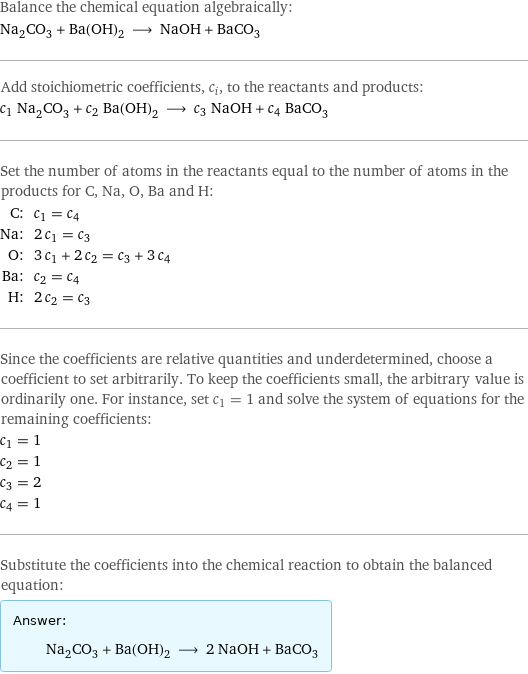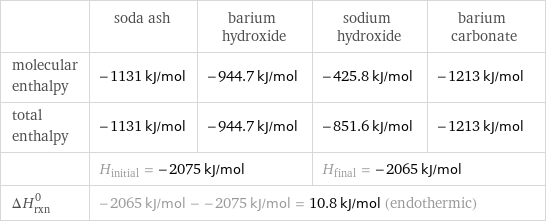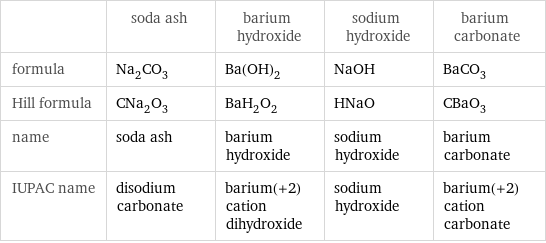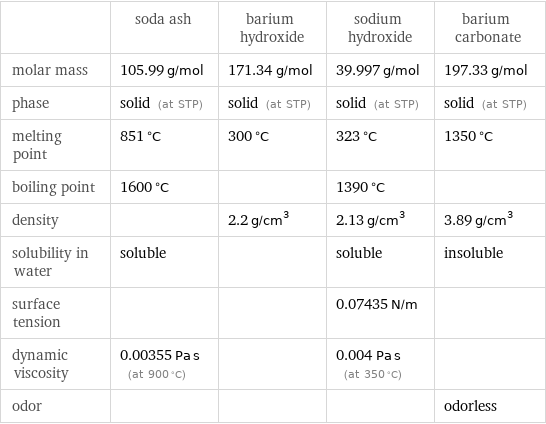Input interpretation

Na_2CO_3 soda ash + Ba(OH)_2 barium hydroxide ⟶ NaOH sodium hydroxide + BaCO_3 barium carbonate
Balanced equation

Balance the chemical equation algebraically: Na_2CO_3 + Ba(OH)_2 ⟶ NaOH + BaCO_3 Add stoichiometric coefficients, c_i, to the reactants and products: c_1 Na_2CO_3 + c_2 Ba(OH)_2 ⟶ c_3 NaOH + c_4 BaCO_3 Set the number of atoms in the reactants equal to the number of atoms in the products for C, Na, O, Ba and H: C: | c_1 = c_4 Na: | 2 c_1 = c_3 O: | 3 c_1 + 2 c_2 = c_3 + 3 c_4 Ba: | c_2 = c_4 H: | 2 c_2 = c_3 Since the coefficients are relative quantities and underdetermined, choose a coefficient to set arbitrarily. To keep the coefficients small, the arbitrary value is ordinarily one. For instance, set c_1 = 1 and solve the system of equations for the remaining coefficients: c_1 = 1 c_2 = 1 c_3 = 2 c_4 = 1 Substitute the coefficients into the chemical reaction to obtain the balanced equation: Answer: | | Na_2CO_3 + Ba(OH)_2 ⟶ 2 NaOH + BaCO_3
Structures

+ ⟶ +
Names

soda ash + barium hydroxide ⟶ sodium hydroxide + barium carbonate
Reaction thermodynamics
Enthalpy

| soda ash | barium hydroxide | sodium hydroxide | barium carbonate molecular enthalpy | -1131 kJ/mol | -944.7 kJ/mol | -425.8 kJ/mol | -1213 kJ/mol total enthalpy | -1131 kJ/mol | -944.7 kJ/mol | -851.6 kJ/mol | -1213 kJ/mol | H_initial = -2075 kJ/mol | | H_final = -2065 kJ/mol | ΔH_rxn^0 | -2065 kJ/mol - -2075 kJ/mol = 10.8 kJ/mol (endothermic) | | |
Equilibrium constant
![Construct the equilibrium constant, K, expression for: Na_2CO_3 + Ba(OH)_2 ⟶ NaOH + BaCO_3 Plan: • Balance the chemical equation. • Determine the stoichiometric numbers. • Assemble the activity expression for each chemical species. • Use the activity expressions to build the equilibrium constant expression. Write the balanced chemical equation: Na_2CO_3 + Ba(OH)_2 ⟶ 2 NaOH + BaCO_3 Assign stoichiometric numbers, ν_i, using the stoichiometric coefficients, c_i, from the balanced chemical equation in the following manner: ν_i = -c_i for reactants and ν_i = c_i for products: chemical species | c_i | ν_i Na_2CO_3 | 1 | -1 Ba(OH)_2 | 1 | -1 NaOH | 2 | 2 BaCO_3 | 1 | 1 Assemble the activity expressions accounting for the state of matter and ν_i: chemical species | c_i | ν_i | activity expression Na_2CO_3 | 1 | -1 | ([Na2CO3])^(-1) Ba(OH)_2 | 1 | -1 | ([Ba(OH)2])^(-1) NaOH | 2 | 2 | ([NaOH])^2 BaCO_3 | 1 | 1 | [BaCO3] The equilibrium constant symbol in the concentration basis is: K_c Mulitply the activity expressions to arrive at the K_c expression: Answer: | | K_c = ([Na2CO3])^(-1) ([Ba(OH)2])^(-1) ([NaOH])^2 [BaCO3] = (([NaOH])^2 [BaCO3])/([Na2CO3] [Ba(OH)2])](../image_source/2a137b7264208ad6ab862fe70bb05aee.png)
Construct the equilibrium constant, K, expression for: Na_2CO_3 + Ba(OH)_2 ⟶ NaOH + BaCO_3 Plan: • Balance the chemical equation. • Determine the stoichiometric numbers. • Assemble the activity expression for each chemical species. • Use the activity expressions to build the equilibrium constant expression. Write the balanced chemical equation: Na_2CO_3 + Ba(OH)_2 ⟶ 2 NaOH + BaCO_3 Assign stoichiometric numbers, ν_i, using the stoichiometric coefficients, c_i, from the balanced chemical equation in the following manner: ν_i = -c_i for reactants and ν_i = c_i for products: chemical species | c_i | ν_i Na_2CO_3 | 1 | -1 Ba(OH)_2 | 1 | -1 NaOH | 2 | 2 BaCO_3 | 1 | 1 Assemble the activity expressions accounting for the state of matter and ν_i: chemical species | c_i | ν_i | activity expression Na_2CO_3 | 1 | -1 | ([Na2CO3])^(-1) Ba(OH)_2 | 1 | -1 | ([Ba(OH)2])^(-1) NaOH | 2 | 2 | ([NaOH])^2 BaCO_3 | 1 | 1 | [BaCO3] The equilibrium constant symbol in the concentration basis is: K_c Mulitply the activity expressions to arrive at the K_c expression: Answer: | | K_c = ([Na2CO3])^(-1) ([Ba(OH)2])^(-1) ([NaOH])^2 [BaCO3] = (([NaOH])^2 [BaCO3])/([Na2CO3] [Ba(OH)2])
Rate of reaction
![Construct the rate of reaction expression for: Na_2CO_3 + Ba(OH)_2 ⟶ NaOH + BaCO_3 Plan: • Balance the chemical equation. • Determine the stoichiometric numbers. • Assemble the rate term for each chemical species. • Write the rate of reaction expression. Write the balanced chemical equation: Na_2CO_3 + Ba(OH)_2 ⟶ 2 NaOH + BaCO_3 Assign stoichiometric numbers, ν_i, using the stoichiometric coefficients, c_i, from the balanced chemical equation in the following manner: ν_i = -c_i for reactants and ν_i = c_i for products: chemical species | c_i | ν_i Na_2CO_3 | 1 | -1 Ba(OH)_2 | 1 | -1 NaOH | 2 | 2 BaCO_3 | 1 | 1 The rate term for each chemical species, B_i, is 1/ν_i(Δ[B_i])/(Δt) where [B_i] is the amount concentration and t is time: chemical species | c_i | ν_i | rate term Na_2CO_3 | 1 | -1 | -(Δ[Na2CO3])/(Δt) Ba(OH)_2 | 1 | -1 | -(Δ[Ba(OH)2])/(Δt) NaOH | 2 | 2 | 1/2 (Δ[NaOH])/(Δt) BaCO_3 | 1 | 1 | (Δ[BaCO3])/(Δt) (for infinitesimal rate of change, replace Δ with d) Set the rate terms equal to each other to arrive at the rate expression: Answer: | | rate = -(Δ[Na2CO3])/(Δt) = -(Δ[Ba(OH)2])/(Δt) = 1/2 (Δ[NaOH])/(Δt) = (Δ[BaCO3])/(Δt) (assuming constant volume and no accumulation of intermediates or side products)](../image_source/68f01edab13ab861d699e67173f0c1f2.png)
Construct the rate of reaction expression for: Na_2CO_3 + Ba(OH)_2 ⟶ NaOH + BaCO_3 Plan: • Balance the chemical equation. • Determine the stoichiometric numbers. • Assemble the rate term for each chemical species. • Write the rate of reaction expression. Write the balanced chemical equation: Na_2CO_3 + Ba(OH)_2 ⟶ 2 NaOH + BaCO_3 Assign stoichiometric numbers, ν_i, using the stoichiometric coefficients, c_i, from the balanced chemical equation in the following manner: ν_i = -c_i for reactants and ν_i = c_i for products: chemical species | c_i | ν_i Na_2CO_3 | 1 | -1 Ba(OH)_2 | 1 | -1 NaOH | 2 | 2 BaCO_3 | 1 | 1 The rate term for each chemical species, B_i, is 1/ν_i(Δ[B_i])/(Δt) where [B_i] is the amount concentration and t is time: chemical species | c_i | ν_i | rate term Na_2CO_3 | 1 | -1 | -(Δ[Na2CO3])/(Δt) Ba(OH)_2 | 1 | -1 | -(Δ[Ba(OH)2])/(Δt) NaOH | 2 | 2 | 1/2 (Δ[NaOH])/(Δt) BaCO_3 | 1 | 1 | (Δ[BaCO3])/(Δt) (for infinitesimal rate of change, replace Δ with d) Set the rate terms equal to each other to arrive at the rate expression: Answer: | | rate = -(Δ[Na2CO3])/(Δt) = -(Δ[Ba(OH)2])/(Δt) = 1/2 (Δ[NaOH])/(Δt) = (Δ[BaCO3])/(Δt) (assuming constant volume and no accumulation of intermediates or side products)
Chemical names and formulas

| soda ash | barium hydroxide | sodium hydroxide | barium carbonate formula | Na_2CO_3 | Ba(OH)_2 | NaOH | BaCO_3 Hill formula | CNa_2O_3 | BaH_2O_2 | HNaO | CBaO_3 name | soda ash | barium hydroxide | sodium hydroxide | barium carbonate IUPAC name | disodium carbonate | barium(+2) cation dihydroxide | sodium hydroxide | barium(+2) cation carbonate
Substance properties

| soda ash | barium hydroxide | sodium hydroxide | barium carbonate molar mass | 105.99 g/mol | 171.34 g/mol | 39.997 g/mol | 197.33 g/mol phase | solid (at STP) | solid (at STP) | solid (at STP) | solid (at STP) melting point | 851 °C | 300 °C | 323 °C | 1350 °C boiling point | 1600 °C | | 1390 °C | density | | 2.2 g/cm^3 | 2.13 g/cm^3 | 3.89 g/cm^3 solubility in water | soluble | | soluble | insoluble surface tension | | | 0.07435 N/m | dynamic viscosity | 0.00355 Pa s (at 900 °C) | | 0.004 Pa s (at 350 °C) | odor | | | | odorless
Units
